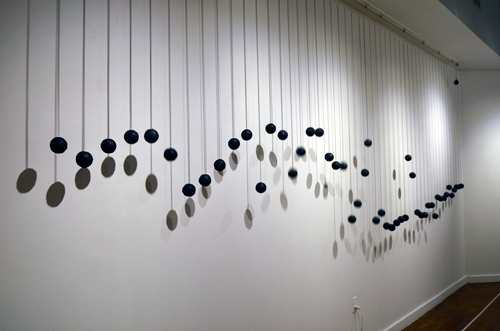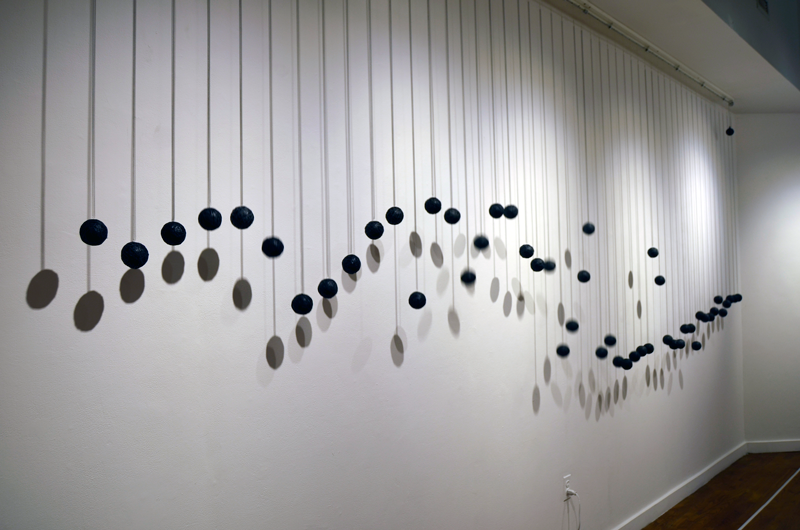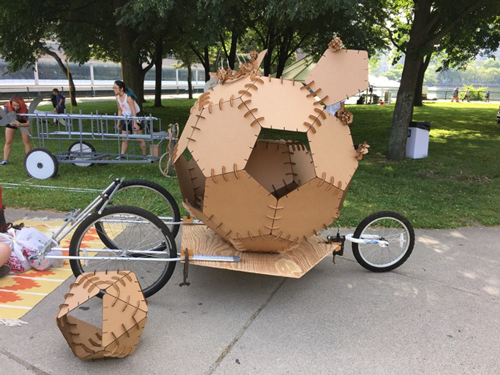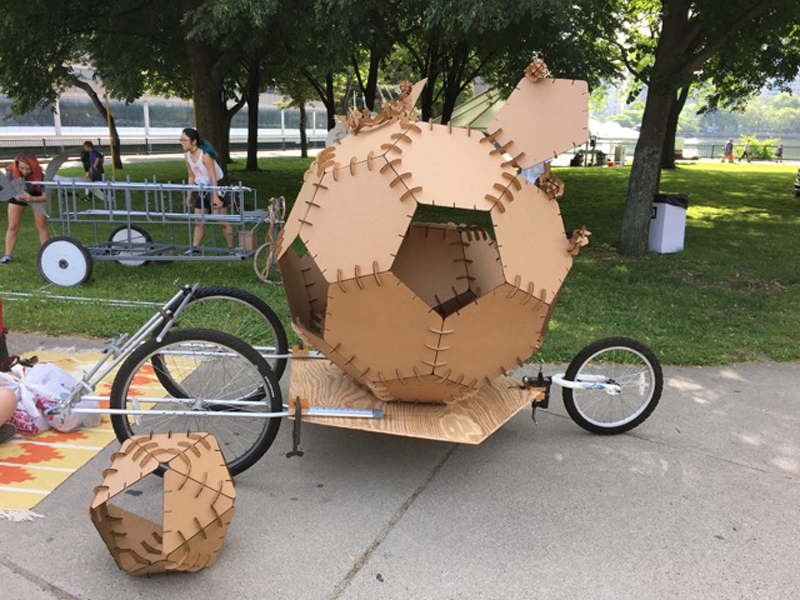Arts & Culture: Sculptor Jumps Headlong into Physics
A chance encounter between the wife of a physics professor and artist Kim Bernard, at one of her exhibitions, led Bernard to put down roots in the unlikely venue of Harvard University’s physics department. For eighteen months, Bernard held the position of the department’s inaugural artist-in-residence, hungrily devouring every physics morsel pushed her way while simultaneously inspiring scientists to embrace their artistic sides.
A sculptor based in Maine, Bernard has long incorporated physical movement into her work, which includes cement spheres oscillating on ceiling-suspended metal springs and rubber balls fixed on steel rods undulating back and forth like a boat on a stormy sea. Viewers are invited to touch, prod, and swing the sculptures so that they move in different ways.
Given the kinetic nature of her work, physics has always been an integral part of Bernard’s sculptures. Before starting the residency, her exposure to the nitty-gritties of physics laws and equations had come through occasional discussions with her oldest son, a physicist who recently started his own company in California, developing new electromagnetic propulsion technology. But at Harvard she was completely immersed in science, interacting with researchers on a daily basis, attending undergraduate labs and lectures on the laws of motion, as well as learning to program tiny computer boards known as Ardunios. “Kim was willing to try and do anything,” said Wolfgang Rueckner, manager of the lecture demo team for natural sciences at Harvard, who worked with Bernard on a couple of her projects. “She was interested in so many things, she just fit right in.”
Bernard was given a space in Harvard’s Science Center’s “Scibox” room, a 2500-square-foot multipurpose space utilized for everything from lectures to theatre rehearsals. Students and faculty coming to use the room had the opportunity to talk to Bernard about the work she had on display, while Bernard gleaned as much information about their research as she could. She also made a point of meeting with professors, touring the lab space, and sitting in on staff lunches. “I was constantly looking for [ideas] that were visually stimulating [and] that I could work from,” said Bernard.
One concept that caught Bernard’s attention was resonance. She was fascinated by the idea that a Mexican-wave-like effect could ripple across a row of balls on suspended springs if these are driven to bounce at the resonance frequency, whereas at another driving frequency the balls might all jump randomly. Interested in reproducing this effect in a large-scale system, Bernard enlisted the help of Robert Hart, who works in Harvard’s undergraduate Instructional Physics Laboratory and manages its fabrication shop. “[Hart] had solutions to problems that I wouldn’t have come up with on my own,” said Bernard, and his hands-on technical skills proved invaluable. To drive the balls in unison, for example, he suggested hanging the springs on a rotating rod, which jiggled the balls and springs up and down at a perfectly pinpointed frequency.
The piece developed into a meters-long sculpture with 50 balls on 50 springs (Fig. 1), with a stepper motor rotating the rod at 80 different frequencies over a 20-minute loop. Hart calculated the exact variation in the balls’ masses needed to create the envisioned Mexican wave extravaganza, which relied on exciting different parts of the sculpture to oscillate at different times as the frequencies were cycled through. Armed with a digital balance, Bernard spent a week painstakingly winding balls from discarded bicycle inner tubes so that the balls’ masses were within one tenth of a gram of Hart’s numbers. They hooked everything together and flicked on the motor.
The balls sprang into motion (see video). But the bounce of the balls didn’t quite follow the neat waves they had planned—the stiffnesses of the 50 springs weren’t perfectly matched. Hart leapt into calculating the corrections on the balls’ masses that were needed to compensate for the stiffness variation. But he soon realized this would require days of tedious work. The slight randomness this disparity added to the wave patterns “was actually very pleasing,” said Hart, so they left the bounce with its quirks. “It had physics and artistic aesthetics,” he added.
As well as creating new sculptures at Harvard, Bernard also encouraged the scientists she met to apply their technical skills to developing their own artwork. One such person was Daniel Rosenberg, the chemistry expert on the lecture demo team. Rosenberg creates art while perfecting newly acquired skills. “You can practice welding by making lines on a piece of sheet metal, or by welding scraps into a structure,” he said. But prior to Bernard’s arrival “[my art] wasn’t polished, there was no overarching vision.”
According to Rosenberg, Bernard encouraged him to step back and think about what message he was trying to communicate in his work, as opposed to “babbling” on. “[Kim] gave me reflection,” he said. Rather than haphazardly putting things together and hoping they fit, Rosenberg now creates with a plan. “I think like an artist, rather than a hacker.” His sculpture “Hatching” (Fig. 2), made from laser-cut cardboard, was entered into the 2016 People’s Sculpture Race in Cambridge, Massachusetts—a 1-mile push or pull of sculptures along the city’s river. To Rosenberg’s “happy surprise,” his sculpture made it over the finish line first.
Bernard’s stay at Harvard finished in June, but she didn’t leave science for long. Already settled in her new home in the College of Arts and Sciences at the University of New England, Maine, as its inaugural artist-in-residence, Bernard is diving into wave-inspired kinetic sculptures made from ocean debris collected by students. She also plans to go surfing for the first time.
–Katherine Wright
Katherine Wright is a Contributing Editor for Physics.







